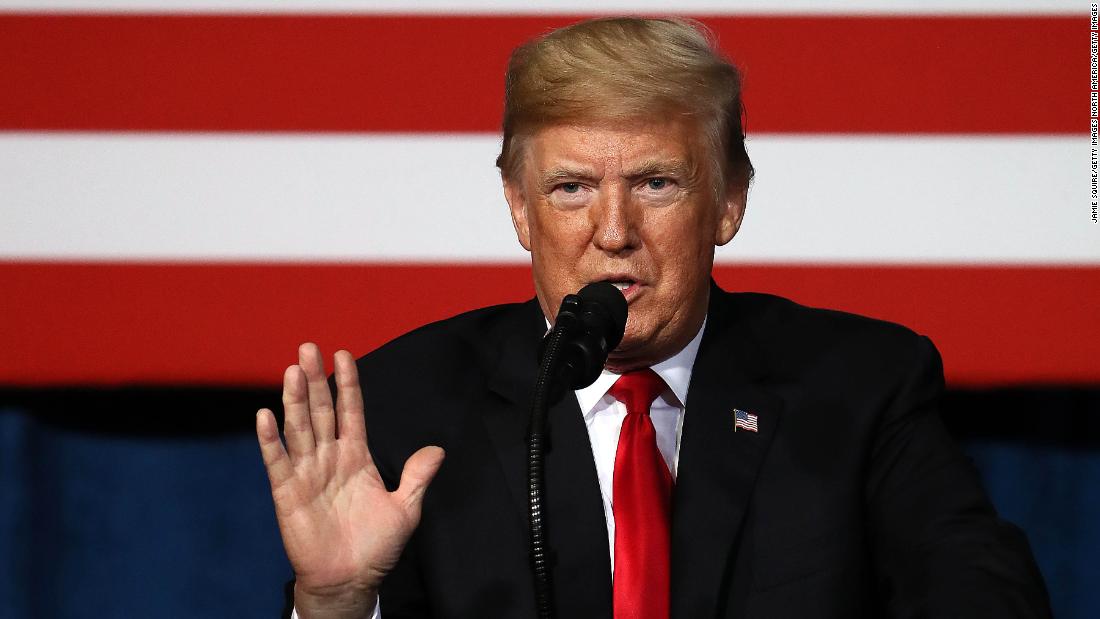
Number of the week: A new Marist College poll finds President Donald Trump's approval rating at 43% among registered voters. His disapproval rating is at 49%.
That's in-line with the FiveThirtyEight average of polls among voters, which puts Trump's approval rating at 42% and his disapproval rating at 52%.
What's the point: The President continues to be unpopular in most polling. Yet, many of his backers and he insist that the average poll doesn't adequately capture his true level of support. Trump and these supporters are mistaken, however.
Just this week, the President tweeted out a result from his favorite pollster, Rasmussen Reports, that showed his approval rating stood at 50%. Rasmussen's polling does not meet CNN standards for a number of reasons including that it doesn't call cell-phones.
The fact that Rasmussen has a better approval rating for the President than other pollsters isn't new. This is why we've seen Trump mention Rasmussen many times. That leads to the media pointing out that other pollsters are far more pessimistic about his standing with voters.
But the average isn't always right. Before last month, there was no way to really know if the average was biased against Trump. It was conceivable that Rasmussen Reports was right. Maybe their likely voter screen was somehow picking up something true about the electorate that other pollsters were missing. Remember, pollsters did somewhat underestimate Trump in the 2016 election.
The midterm elections prove that at least for now Rasmussen is dead wrong and traditional pollsters are correct.
In the final three weeks before the midterm, 16 different pollsters released generic congressional ballot polls. Some of those pollsters, including Rasmussen, released multiple polls. In total, there were 32 generic ballot polls put out.
The generic ballot isn't a perfect estimate of the House popular vote because often pollsters don't mention the specific candidates running in each district and some districts don't feature candidates from both parties running. Still, these factors tend to cancel each other out nationally and are only worth a point or 2 at the very most. They don't excuse Rasmussen's midterm performance.
Rasmussen's final poll was the least accurate of any of the 32 polls. They had the Republicans ahead nationally by one point. Democrats are currently winning the national House vote by 8.6 points. That's an error of nearly 10 points.
Of course, it's possible for any pollster to have one inaccurate poll. Fortunately, for statistical purposes, Rasmussen released three generic ballot polls in the final three weeks of the 2018 campaign.
The average Rasmussen poll had Democrats ahead by 1.7 points on the generic ballot. That's an underestimation of their eventual position of nearly 7 points. This made Rasmussen's average poll more inaccurate than any other pollster.
Looking at all pollsters, the average poll hit the mark nearly perfectly. The average gold standard poll (i.e. ones that use live interviews, calls cell phones and is transparent about its practices) over the final three weeks of the campaign had Democrats ahead by 9.4 points on the generic congressional ballot. That's an error of less than a point. The average pollster overall, according to the FiveThirtyEight aggregate, had Democrats up by 8.7 points. Once all the votes are counted, that could have hit the nail on the head.
The accuracy of the generic ballot polling shouldn't be surprising given how well pollsters did in gauging Trump's own popularity. As I noted previously, the President's net approval rating in the average pre-election poll of voters was identical to what it was in pre-election polls.
Rasmussen's average net approval rating, on the other hand, was far too optimistic for the president. It was -1.5 points on Election Day, which was 7.5 points higher than the exit poll found. That is, Rasmussen's net approval rating of Trump was by about as off as Rasmussen generic ballot was.
When most pollsters get the results as wrong as Rasmussen did in 2018, they go into deep introspection. You can read the long report the American Association for Political Opinion (AAPOR) issued after the 2016 election.
Rasmussen, apparently, has done no such thing. Instead, they claim that the midterm result was relatively poor for Democrats compared to other midterms. It was actually one of the best in the House on record. Indeed, Rasmussen looks to be mostly satisfied by their polling.
Rasmussen has company in that regard. It seems that the President continues to be satisfied with their numbers as well.
No comments:
Post a Comment